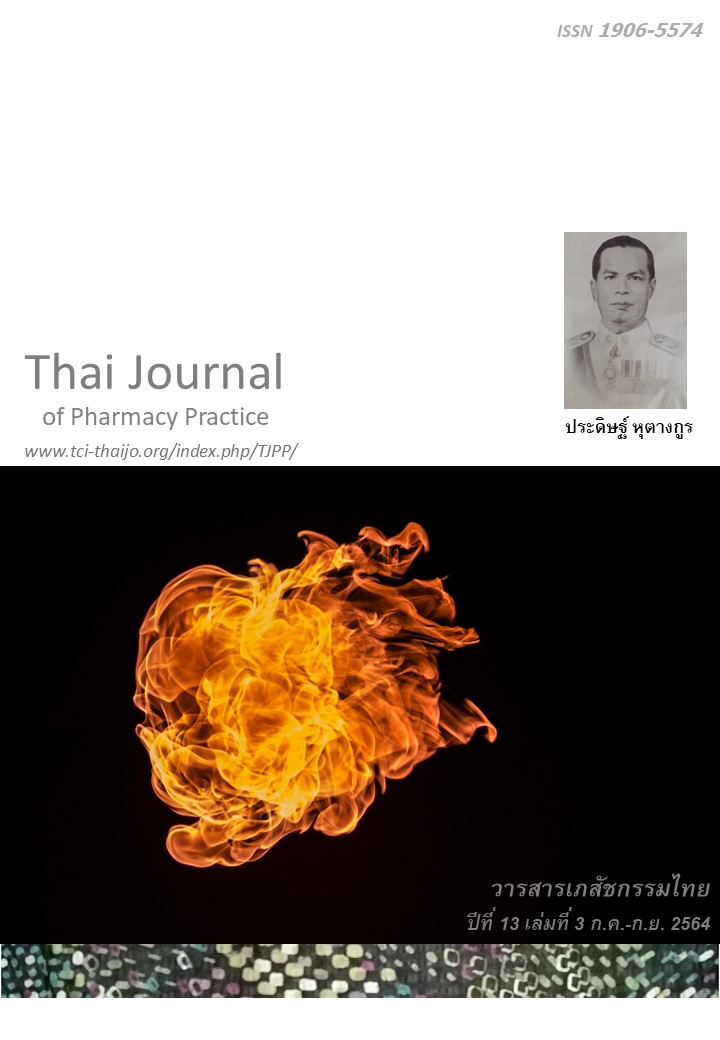ปัญหาการเก็บรักษายาอย่างไม่เหมาะสมที่พบจากการสำรวจยาที่ผู้ป่วยโรคเรื้อรังนำมาขณะเข้ารักษาตัวในโรงพยาบาล
Main Article Content
บทคัดย่อ
วัตถุประสงค์: เพื่อค้นหาปัญหาที่สำคัญและพบบ่อยในการเก็บรักษายาของผู้ป่วยโรคเรื้อรังที่เข้ารับการรักษาตัวในโรงพยาบาล วิธีการ: การวิจัยนี้เป็นการศึกษาเชิงพรรณนาโดยสังเกตยาที่ผู้ป่วยโรคเรื้อรัง 1,046 คนนำมาจากบ้านขณะนอนรักษาตัวในโรงพยาบาลระหว่างมีนาคม- กันยายน 2562 เภสัชกรสังเกตยาจากลักษณะทางกายภาพภายนอกเพื่อค้นหาปัญหาในหมวดการพิสูจน์อัตลักษณ์เม็ดยาและหมวดคุณภาพ เภสัชกรให้การแทรกแซงและสอบถามการบริหารยาของผู้ป่วยในวันกลับบ้าน ผลการศึกษา: ผู้ป่วยส่วนใหญ่เป็นเพศชาย (ร้อยละ 56.9) มีอายุในช่วง 61-80 ปี (ร้อยละ 40.1) มีผู้ดูแลเป็นผู้จัดยาให้รับประทาน (ร้อยละ 41.1) จำนวนรายการยาที่นำมาโรงพยาบาล คือ 4-6 รายการต่อราย (ร้อยละ 40.1) พบปัญหาจากการเก็บรักษายาทั้งหมด 483 ปัญหาในผู้ป่วยจำนวน 394 ราย (ร้อยละ 37.7) โดยส่วนใหญ่เป็นปัญหาด้านการพิสูจน์อัตลักษณ์เม็ดยา จำนวน 366 ปัญหา (ร้อยละ 75.58) ปัญหาใหญ่ 2 ลำดับแรก คือ ปัญหาซองยาไม่มีฉลากวิธีใช้ยา 149 ปัญหา (ร้อยละ 40.71) และปัญหาผู้ป่วยได้รับยาชนิดเดียวกันจากหลายแหล่ง หลายชื่อการค้า หรือหลาย Lot. Number 122 ปัญหา (ร้อยละ 33.33) การศึกษาพบปัญหาด้านคุณภาพยา พบจำนวน 117 ปัญหา (ร้อยละ 24.22) โดยปัญหาส่วนใหญ่ที่พบ คือ ซองยาสกปรกมีสิ่งปนเปื้อนในถุงยา 79 ปัญหา (ร้อยละ 67.52) สรุป: ปัญหาที่สำคัญและพบบ่อยในการเก็บรักษายาของผู้ป่วยโรคเรื้อรัง คือ การไม่มีฉลากยา/ไม่มีวิธีใช้ยา การได้รับยาชนิดเดียวกันหลายชื่อการค้า และซองยาสกปรกมีสิ่งปนเปื้อนในถุงยา ข้อมูลดังกล่าวสามารถใช้เพื่อพัฒนาการแทรกแซงและเป็นแนวทางในการให้คำแนะนำผู้ป่วยในวันกลับบ้านได้อย่างตรงประเด็น เพื่อให้เกิดความปลอดภัยจากการใช้ยา
Article Details
ผลการวิจัยและความคิดเห็นที่ปรากฏในบทความถือเป็นความคิดเห็นและอยู่ในความรับผิดชอบของผู้นิพนธ์ มิใช่ความเห็นหรือความรับผิดชอบของกองบรรณาธิการ หรือคณะเภสัชศาสตร์ มหาวิทยาลัยสงขลานครินทร์ ทั้งนี้ไม่รวมความผิดพลาดอันเกิดจากการพิมพ์ บทความที่ได้รับการเผยแพร่โดยวารสารเภสัชกรรมไทยถือเป็นสิทธิ์ของวารสารฯ
เอกสารอ้างอิง
Hepler CD, Strand LM. Opportunities and responsi bilities in pharmaceutical care. Am J Hosp Pharm 1990; 47: 533-43.
Hanrinth R. Classification for drug related problems. Thai Journal of Pharmacy Practice 2009; 1: 84-96.
Leetaweesuk J, Mekee P, Thawee P, et al. Drug use behaviors of elderly patients with chronic disease in Chiang-Tong community Rahang Sub-District, Muang-Tak District, Tak Province [online]. 2017 [cited Jan 9, 2020].Available from: www.tsm.go.th/ res/uncategorized/hello-world/.
Chaichanawirote U, Vithayachockitikhun N. Medica tion use behaviors among older Thai adults. Journal of Nursing and Health Sciences 2015; 9: 32-46.
Rachaniyom S, Saramunee K. Family pharmacist’s management of drug related problems for chronic diseases at patient’s in home, Kranuan district health network. Thai Journal of Pharmacy Practice 2016; 8: 169-81.
Suksri H, Sriring P, Karnchanaraj T. Medications related-problems of patient at home, community of Amphur Muang, Khon Kaen [online]. 2010 [cited Jan 9, 2020]. Available from: tdc.thailis.or.th/tdc//browse .php?option=show&browse_type=title&titleid=265855&query=%A1%D2%E1%BF&s_mode=any&d_field=&d_start=0000-00-00&d_end=2561-08-27&limit_ la ng=&limited_lang_code=&order=&order_by=&order_type=&result_id=51&maxid=106
Chaimeekhieo N, Srisaenpang P. Medication self-management among older persons with multimor bidity in community. Journal of Nursing and Health Care 2017; 35: 148-157.
Wungthanakorn S, Phatidumrongkul C, Khomchan P. Factors affecting medication taking behaviors in hypertensive patients.Songklanakarind Medical Jour nal 2008; 26: 539-47.
Yuychim P, Niratharadorn M, Siriumpunkul P, Bua boon N. Effects of a family participation program in managing drug managing drug use behaviors among older adults with chronic diseases in Phun Phin community. Journal of Public Health 2018; 48: 44-56.
Poophalee T, Koonsawat C, Phuradchaphon T, Srisaknok T. Explanations and handling of unused medicines in patients with Type 2 diabetes and hypertension: a case of a community at Ubon Ratchathani. Thai Journal of Pharmacy Practice 2018; 10: 3-13.
Kuntee M. Evaluation of pharmaceutical care service for chronic disease patients at home. Clinical Pharmacy Journal 2017; 23: 32-43.
Champati S. Causes of patient’s medication problems and interventions in home care visits by pharmacists. Clinical Pharmacy Journal 2017;23:19.


